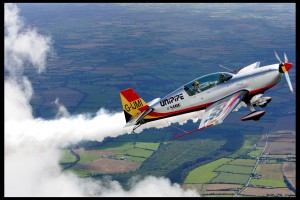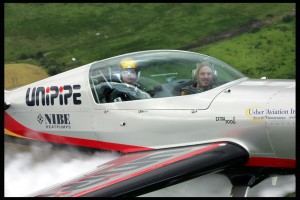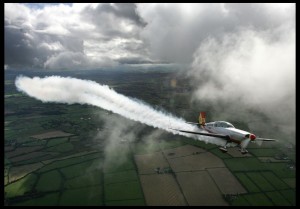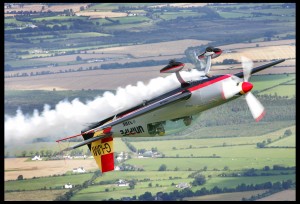Features
Published: Irish Times, September 20 2008UP, UP AND AWAY
 A CUP OF TEA. A bowl of corn flakes. Two slices of brown toast with margarine and honey . . . If someone had asked me on the tarmac what I ate for breakfast this morning, I doubt I’d have been able to recall. Hurling upside down through a bank of clouds at 250 miles per hour, though, I can recount every tiny detail, from the brand name of the margarine, to the expiration date on the milk.
A CUP OF TEA. A bowl of corn flakes. Two slices of brown toast with margarine and honey . . . If someone had asked me on the tarmac what I ate for breakfast this morning, I doubt I’d have been able to recall. Hurling upside down through a bank of clouds at 250 miles per hour, though, I can recount every tiny detail, from the brand name of the margarine, to the expiration date on the milk.
It’s a white knuckle ride.
Pilot Eddie Goggins mentioned that one of the keys to success in aerobatics is an ability to make precise split-second calculations. Well, right now, I calculate that there’s a 50/50 chance the contents of my stomach will be splattered all over his pristine canopy by the time this flight is over.
Eddie Goggins is no shrinking violet. But as an Irishman who defied tragedy to claim bronze at the Advanced World Aerobatic Championships last month, you’d hardly expect him to be. He is a born show off: a square-jawed, Steve Silvermint-type who thrives on adrenalin and relishes danger. Over the years, the Dublin-based dentist has tried his hand at parachuting, bungee-jumping and even motor racing. What attracted him to competition aerobatics, he says, is the challenge of competing solely on his own terms. “You’re in the sky on your own so it’s all down to your own performance. You can never achieve the perfect flight. But you can get very close.”
Barrelling down the runway at Kilrush Airfield in Co Kildare today in his Extra 300L plane, we shoot into the sky with a stomach-churning vertical ascent. Four seconds after leaving the runway we’re levelling off at an altitude of 1,000 feet and continuing our climb at a more leisurely 3,000 feet per minute. All the while, the 39-year-old Roscommon native keeps me entertained with a succession of unannounced rolls and loop-the-loops. The view is extraordinary: fields, forests, lakes and bogs – stretched out above, below, behind and (at times) directly ahead of us – like some enormous, spinning tablecloth.
 On the headset, Eddie maintains close contact with the pilot of the helicopter that’s tracking us just a short distance away. “What type of lens is the photographer using?” he asks. “She might want to adjust her shutter speed in this light.” For a while I wonder if he even remembers that your nauseous correspondent is even in the plane. “Let’s head over to that cloud formation due east,” he instructs the chopper. “We’ll get some fantastic shots over there!” Eventually, he acknowledges my presence. “How you feeling there, Ian?” he inquires. “Terrific,” I reply. “Really terrific.” “Grab a hold of the joystick in front of you then,” he says. “I’m giving you control of the aircraft!”
On the headset, Eddie maintains close contact with the pilot of the helicopter that’s tracking us just a short distance away. “What type of lens is the photographer using?” he asks. “She might want to adjust her shutter speed in this light.” For a while I wonder if he even remembers that your nauseous correspondent is even in the plane. “Let’s head over to that cloud formation due east,” he instructs the chopper. “We’ll get some fantastic shots over there!” Eventually, he acknowledges my presence. “How you feeling there, Ian?” he inquires. “Terrific,” I reply. “Really terrific.” “Grab a hold of the joystick in front of you then,” he says. “I’m giving you control of the aircraft!”
That’s one of the snags with irony. It doesn’t always translate at 4,000 feet.
From the time he was a little boy, Goggins dreamed of flying. His father was an engineer in the US Air Force and photographs of fighter planes adorned the walls of their house. As an 18-year-old dental student, he eschewed late-night carousing to save up for flying lessons. But it wasn’t until he graduated that he could afford to pursue the sport in earnest. Flying is an expensive hobby. Since gaining his instructor’s licence, he has been able to offset some of the costs involved by giving lessons. But they’re steep nonetheless. The plane we’re flying in today – which he co-owns with three other pilots – cost €220,000 to purchase secondhand.
That’s just for starters. There are also hangar costs, fuel costs, maintenance costs and insurance costs. “There are a lot of regular mandatory checks that have to be carried out,” explains Goggins. “A lot of parts have to be dissembled and inspected. We’re lucky we’ve got an amazing organisation in Sligo airport doing our maintenance for us, that’s really a huge help.” Events such as the Salthill Air Show in Galway bring in revenue, but the associated insurance outlay is very high. “At air shows the public want drama. So you need to get low and you need to get close. The risks are higher because the margins for error are smaller.”
The risks involved in stunt flying are, unfortunately, something of which Goggins is only too well aware. At an Aero GP in Malta in September 2006, he found himself involved in a tragic mid-air collision with another pilot. While executing a climbing turn in an air race, Goggins and Gabor Varga of Sweden collided. Both aircraft were critically damaged. The Irishman managed to save himself by gaining enough altitude before his aircraft disintegrated to parachute safely. In dramatic footage that’s available to access on the internet, his parachute can be seen opening a split second before he hits the water. The Swede, meanwhile, plummeted to his death in the Mediterranean Sea.
 Understandably, the accident is not something that Eddie is very comfortable talking about. “All I’ll say is that it was a collision that happened at one of the corners,” he says, quietly. “I bailed out and landed in the sea. The other pilot . . . didn’t get out.” Does he feel at all guilty about the other pilot’s death? Goggins considers the question for a moment. “Look,” he answers, “I have to be careful how I put this. But I was racing him. Anyone who participates in any motor racing sport understands the risk they’re taking.” For a year afterwards, he gave up flying completely. “I wasn’t nervous about it, I wasn’t afraid for my own safety,” he says. “That wasn’t the reason. I just felt that for the sake of my wife and two children I should give it up. I have a great family life and that has to be the number one priority.”
Understandably, the accident is not something that Eddie is very comfortable talking about. “All I’ll say is that it was a collision that happened at one of the corners,” he says, quietly. “I bailed out and landed in the sea. The other pilot . . . didn’t get out.” Does he feel at all guilty about the other pilot’s death? Goggins considers the question for a moment. “Look,” he answers, “I have to be careful how I put this. But I was racing him. Anyone who participates in any motor racing sport understands the risk they’re taking.” For a year afterwards, he gave up flying completely. “I wasn’t nervous about it, I wasn’t afraid for my own safety,” he says. “That wasn’t the reason. I just felt that for the sake of my wife and two children I should give it up. I have a great family life and that has to be the number one priority.”
Aviation, though, is Goggins’ lifeblood and without it he soon became morose and withdrawn. In the end, it was his wife who coaxed him to get back up in the sky. “She was the one who encouraged me,” he smiles. “I think she was fed up having to deal with grumpy Eddie all the time.”
The accident, however, was never going to be something that he could just shrug off. He would no longer take part in air races, for starters, he decided. He also reassessed his own safety limits. “I’m comfortable with what I do now,” he says. “I don’t feel that I’m taking any unnecessary risks. I’m sure some people will find it funny to hear me say that. But in the past, I would have been comfortable with tighter margins. Now I like to leave a little extra for the wife and kids.”
A few months before the tragedy occurred, Goggins had finished 22nd at the bi-annual Advanced World Aerobatic Championships in Poland. Returning to flying in November 2007, he decided to see if he could improve on that finish at the 2008 tournament in Pendleton, Oregon. With only eight months to prepare, training was intensive. As a birthday gift, his wife arranged for a renowned international aerobatics coach to visit Ireland to assist. “That was a big help. To gain expertise you need someone on the ground giving you feedback on how your shapes look. A good coach is a rare thing.”
At the competition in August 2008, Goggins describes himself as having arrived as a “Johnny No-Mates”. Most national teams had a coach, a mechanic and an extensive entourage of hangers-on. Goggins travelled alone. Worse, because of the distance involved, he couldn’t bring his own aircraft. Valuable practice time was spent adjusting to a new plane he had hired. In competition aerobics, pilots have to fly different sequences, some of which they get to practice in advance, others they’re only presented with on the day. “There are hundreds of thousands of manoeuvres you could be asked to do. So when the sequences are published, they might include things you haven’t tried in months.”
 The key to Goggin’s success was attention to detail. “Taking into account wind speeds, making sure the shapes appear symmetrical from where the judges are sitting, at least. Those are the things you concentrate on. Every five degrees you are off, you’re going to lose a point. Each manoeuvre has a maximum score of 100 per cent. So if you over-rotate by stomping on the rudder too early or too late, you can easily throw away 10 per cent.” Goggins’s other great strength in Oregon was his consistency. In all of the rounds he contested, he never achieved a top-three finish. But, while other pilots all made mistakes that cost them places, he was always thereabouts.
The key to Goggin’s success was attention to detail. “Taking into account wind speeds, making sure the shapes appear symmetrical from where the judges are sitting, at least. Those are the things you concentrate on. Every five degrees you are off, you’re going to lose a point. Each manoeuvre has a maximum score of 100 per cent. So if you over-rotate by stomping on the rudder too early or too late, you can easily throw away 10 per cent.” Goggins’s other great strength in Oregon was his consistency. In all of the rounds he contested, he never achieved a top-three finish. But, while other pilots all made mistakes that cost them places, he was always thereabouts.
In the end, Goggins’s status as an unknown quantity may have worked to his advantage. In aerobatics, all manoeuvres must be executed within a defined performance zone of a 1,000 metres cubed. Pilots who stray outside that box are penalised. But the top pilots tend only to scrutinise the calls on pilots they consider a threat. If a perceived infringement is not penalised they’ll contest the call, and if protest is upheld they can knock an opponent down a few points. Goggins was the only pilot in the first three sequences to have no highs, no lows and no zeros. “I don’t think they even noticed me until the final round!” he laughs.
False modesty aside, taking the bronze at a world championship event was undoubtedly a stunning achievement for the Irish pilot. So where does Goggins’ career go from here?
The first priority, he says, is to attract more sponsorship to the sport. (“We’ve had a great year with our existing sponsors, Unipipe Ireland and Aviation Ireland. But it’s time to start planning for the 2009 season now.”) He also plans to establish a school for advanced aerobatic pilots which, he hopes, will attract students, not just from Ireland, but from farther afield. If all goes according to plan, dozens of wannabe daredevils may soon be benefiting from Goggins’ undoubted expertise.
Whether that ambition is ever realised or not, it is to be hoped that Goggins is never again forced to instruct a pupil as reluctant as the one he’s coaching this morning. In the clouds above south Co Kildare, he is giving me a quick run through of what I need to do in order to execute a loop-the-loop. To be honest, I’m so nauseous I don’t even care how you execute a loop-the-loop. But I’m too sick now to complain. I take hold of the control column and pull it slowly back toward me. I wince as the nose of the plane suddenly veers upwards.
The years to come seemed waste of breath/ A waste of breath the years behind . . .
[P.S.: The reason I’m not wearing a helmet was because there wasn’t one in the entire airfield big enough to fit my head. That’s not a joke.]
